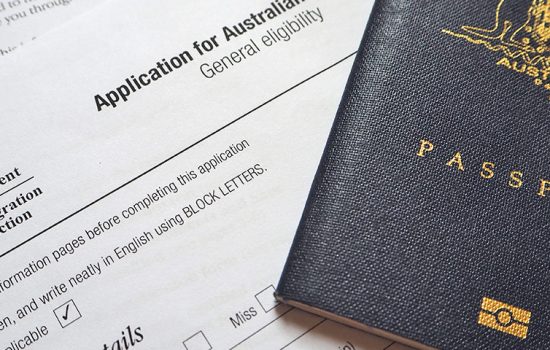Several visa options may be available for a parent to migrate to Australia permanently or temporarily.
The visas vary in terms of:
- Permanent or temporary visas
- Cost of visas
- Processing times
- Age
- Eligibility requirements to fulfill such as the ‘balance of family test’ and ‘assurance of support’
What visa options are available for parents?
Aged Parent visa (subclass 804)
- This is a parent visa that is applied for when the visa applicant is in Australia, meaning you are ‘onshore’
- You will be granted a bridging visa associated with the application, and will be able to remain in Australia while it is being processed
- When being granted this visa, you must be in Australia
- You must be at the Australian pension age
- There is a queueing system in place for the Aged Parent visa. This means that you must be prepared to wait in a queue for the visa to be processed. According to the Department of Home Affairs website, new applications lodged that meet the criteria to be queued are likely to take many years for final processing
- The cost of applying for this visa is significantly less than for the Contributory Aged Parent (Temporary) Visa (subclass 884)
Contributory Aged Parent (Temporary) visa (subclass 884)
- This is a parent visa that is applied for when the visa applicant is in Australia, meaning you are ‘onshore’
- This visa will allow you to live in Australia for 2 years once it is granted, with the option of applying for the permanent visa
- You must be at the Australian pension age
- You will be granted a bridging visa associated with the application, and will be able to remain in Australia while it is being processed
- When being granted this visa, you must be in Australia
- The cost of applying for this visa is considerable
- The processing time for this visa is far less than the than the Aged Parent Visa, though it may still take several years
Contributory Aged Parent visa (subclass 864)
- This is a parent visa that is applied for when the visa applicant is in Australia, meaning you are ‘onshore’
- This visa will allow you to live in Australia permanently
- You will be granted a bridging visa associated with the application, and will be able to remain in Australia while it is being processed
- You must be at the Australian pension age
- When being granted this visa, you must be in Australia
- The cost of applying for this visa is significantly higher than the Aged Parent Visa
- The processing time for this visa is far less than the than the Aged Parent Visa, though it may still take several years.
Contributory Parent (Temporary) visa (subclass 173)
- This is a parent visa that is applied for when the visa applicant is either in or outside Australia
- This visa will allow you to live in Australia for 2 years with the option of applying for the permanent visa
- You will be granted a bridging visa associated with the application, and will be able to remain in Australia while it is being processed
- When being granted this visa, you must be in Australia
- The cost of applying for this visa is significantly higher than the Aged Parent visa
- The processing time for this visa is far less than the than the Aged Parent visa, though it may still take several years.
Contributory Parent visa (subclass 143)
- This is a parent visa that is applied for when the visa applicant is either in or outside Australia depending on the certain circumstances
- When being granted this visa, you must be outside Australia, unless certain criteria are met
- This visa will allow you to live in Australia permanently
- The cost of applying for this visa is significantly higher than the Parent visa
- The processing time for this visa is far less than the than the Parent visa, though it may still take several years
Parent visa (subclass 103)
- This is a parent visa that is applied for when the visa applicant is either in or outside Australia depending on the certain circumstances
- When being granted this visa, you must be outside Australia, unless certain criteria are met
- This visa will allow you to live in Australia permanently
- The cost of applying for this visa is significantly higher than the Contributory Parent visa
- The processing time for this visa is far longer than the Contributory Parent visa
Sponsored Parent (Temporary) visa (subclass 870)
- This is a temporary parent visa that is applied for when the visa applicant is offshore
- A sponsorship application must be lodged and approved first before a visa application can be lodged. The visa can be granted when you are in or outside or Australia
- This visa allows you to stay in Australia for 3 to 5 years
- Further visa applications could facilitate a stay of maximum up to 10 years, but you must go offshore and spend 90 days outside of Australia before the next visa application can be made
- As part of the application, you will need to show that you genuinely intend to stay in Australia temporarily, and will not stay beyond the time you are permitted
- There is no requirement to satisfy the Balance of Family test for this visa
What are the eligibility requirements for parent visas?
Each parent visa has different requirements, and can be complex to navigate and find the best option. We recommend speaking with our expert migration lawyers to determine the best parent visa pathway for your family.
Some generally common requirements are explained below.
Sponsorship
Many parent visas require that the visa applicant be sponsored by an Australian citizen, permanent resident, or eligible New Zealand citizen child over the age of 18 years.
The meaning of ‘child’ can be biological, adopted, step, and in some circumstances in-law parent-child relationships.
In some circumstances where the Australian child is under the age of 18, another relative or community organisation may be able to be the sponsor.
Some common aspects that may be relevant to a sponsorship application are:
- The sponsor’s Australian citizenship, permanent residency status, or eligible New Zealand citizen status
- Whether the sponsor child is ‘settled’ in Australia – i.e. that they have been usually resident in Australia
- Financial circumstances, such as whether the sponsor can financially support the visa applicant (this factor is relevant to many parent visas)
Common requirement – Balance of family test
This test is a requirement for the visa applicant to have more children in Australia than any other single country (i.e. not cumulatively across all countries). Children in this case includes biological, step and adopted children.
Example: a person who has two biological Australian citizen children residing in Australia, one child in Canada, another in the US, and another in UK; such a person would meet the balance of family test as they have more children living in Australia than any other single country.
Common requirement – Assurance of support
An assurance of support is an agreement with the government to financially assist the migrating family member if and when necessary to ensure that the cost to the Australian community is minimised. The agreement is a contractual promise to pay back any social security benefits (e.g. Centrelink payments) that are received.
Health and Character requirements
There are also health and character requirements that must be met for a successful parent visa application.



